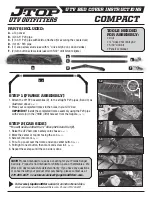
Page 32
4
.
Remove the four nuts and lock washers and withdraw the
pump assembly from the studs on the cylinder block, including the
gasket.
To replace
1.
Clean the faces of the water pump and cylinder block and
fit a new gasket.
2.
Fit the pump assembly over the studs and secure it to the
face of the cylinder block with four nuts and lock washers, tightening
to a torque of 1.66 to 2.07 kg/m (12 to 15 lb/ft).
3.
Reconnect the heater and heat exchanger hoses.
4.
Replace the fan belt and adjust the tension (Operation 4).
5.
Refit radiator, connect hoses, refill the cooling system and
check for leaks.
Operation 4 Fan belt adjustment
Correct fan belt tension is important, otherwise the belt itself may be
damaged, or undue strain placed on the alternator or water pump
bearings. If the belt is too slack, poor battery charging could result.
The correct tension of the fan belt is such that when the belt is pushed
at a point midway between the alternator and water pump pulleys, a
deflection of 13 mm (½ inch) is necessary.
To adjust
1.
Loosen the alternator front lower mounting bolt.
2.
Slacken the adjustment locking screw at the front of the
alternator allowing the alternator to be moved on the slotted strap.
3.
Pivot the alternator towards or away from the engine as
necessary until the correct belt tension is obtained.
4.
Securely tighten the locking screw and lower front
mounting bolt.
Note:
The lower front mounting bolt
MUST
be slackened completely
before making any adjustment as any strain on the lower fixing could
distort or damage the mountings.
Operation 5 Fan belt removal and replacement
1.
Loosen the alternator front lower mounting bolt.
2.
Slacken the adjustment locking screw at the front of the
alternator allowing the alternator to be moved on the slotted strap.
3.
Pivot the alternator towards the engine and remove the fan
belt. It is vital that the alternator is pivoted to its fullest extent. Any
attempt to strain a new belt over the sides of the pulleys will easily
cause damage to the belt.
Operation 6 Thermostat removal and replacement
The wax type thermostat is located in a housing at the front of the
cylinder head. When the coolant is cold, the thermostat is in the
closed position and water flow is restricted within the engine by
means of a by-pass hose system (through the heater matrix and the
inlet manifold heat exchanger). Coolant flowing through the by-pass
returns to the water pump. When the thermostat is fully open,
complete circulation through the engine block, cylinder head and
radiator takes place.
To remove
1.
Drain the cooling system as described in operation 1 and
remove the top hose.
2.
Unscrew the three set screws, complete with lock washers.
Lift off the thermostat housing and remove the thermostat.
(
see Section F, Figure 13
)
Testing the thermostat
If it is suspected that the thermostat is not operating correctly, it
Figure 5 Fan belt adjustment
1.
Adjustment locking screw
2.
Alternator front lower mounting bolt
may be tested in the following manner:-
Suspend the thermostat in water in a suitable container, gradually
heating the water. Check the water temperature frequently using a
thermometer. The thermostat or thermometer must not directly
touch the container or the reading will not be accurate.
The thermostat should start to open at 86 to 89°C (187 to 193° F) and
be fully opened when the water is boiling.
If the thermostat does not operate correctly then a new one must be
fitted. It is not possible to repair or adjust this item.
To replace
1.
Position thermostat in its housing and fit a new gasket.
2.
Place the thermostat cover with the outlet facing forward
and secure with the three set screws and lock washers (do not over
tighten).
3.
Refit the top hose and refill the cooling system. Check for
water leaks.
Temperature gauge and sender unit - Fault diagnosis
The temperature gauge reading depends upon the variation of
resistance of a thermistor.
If faulty readings are suspected on the gauge, check the gauge and the
sender unit as follows:-
Diagnosis
1.
With the ignition switched on, disconnect the wire from the
sender unit on the cylinder head, the temperature gauge needle
should then be at the cold mark.
2.
Now hold the wire to earth and the gauge needle should
move all the way across to the hot mark.
This would indicate that the gauge itself is operating correctly.
The above result would suggest that inaccurate readings are due to
the sender unit, which must be replaced, a fault in the wiring, a loose
connection, a faulty voltage stabiliser or a defective gauge. If the
gauge is deemed defective, the unit will need to be replaced, see
Section T.
.
Содержание Kitten Estate
Страница 15: ...Page 15...
Страница 17: ...Page 17...
Страница 22: ...Page 22...
Страница 26: ...Page 26...
Страница 38: ...Page 38 Figure 4 Engine cylinder block exploded...
Страница 54: ...Page 54...
Страница 55: ...Page 55...
Страница 65: ...Page 65...
Страница 66: ...Page 66...
Страница 75: ...Page 75...
Страница 77: ...Page 77...
Страница 90: ...Page 90...
Страница 92: ...Page 92...
Страница 97: ...Page 97...
Страница 100: ...Page 100...
Страница 101: ...Page 101...
Страница 103: ...Page 103...
Страница 108: ...Page 108...
Страница 114: ...Page 114...
Страница 116: ...Page 116...
Страница 117: ...Page 117...
Страница 118: ...Page 118...
Страница 119: ...Page 119...
Страница 120: ...Page 120...
Страница 123: ...Page 123...
Страница 124: ...Page 124...
Страница 126: ...Page 126...
Страница 130: ...Page 130...
Страница 131: ...Page 131...
Страница 133: ...Page 133...
















































